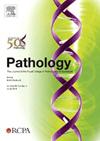Frequent PIK3CA and GNAQ mutations in solitary pulmonary capillary haemangioma and pulmonary cavernous haemangioma: genetic link to vascular malformations
IF 3
3区 医学
Q1 PATHOLOGY
引用次数: 0
Abstract
Pulmonary haemangiomas are rare diseases with unclear pathogenesis. The molecular alterations underlying these conditions have not yet been identified. In this study, we sought to investigate the genetic alterations in the two most common types of pulmonary haemangiomas: solitary pulmonary capillary haemangiomas (SPCH) and pulmonary cavernous haemangiomas. This study included six patients with SPCH and four patients with pulmonary cavernous haemangioma. Utilising a customised next-generation sequencing panel, we identified a high frequency of PIK3CA hotspot mutations—five of six SPCH cases and three of four pulmonary cavernous haemangiomas, totalling 80%. Additionally, GNAQ mutations were detected in one SPCH and one pulmonary cavernous haemangioma. Overall, nine of 10 (90%) of the pulmonary haemangiomas in our study harboured mutations in either the PIK3CA or GNAQ genes. The variant allele frequencies of these mutations were relatively low, ranging from 4.2% to 15.5%, which complicates detection using Sanger sequencing due to its lower sensitivity. Our study identified a high frequency of PIK3CA mutations and occasional GNAQ mutations in SPCH and pulmonary cavernous haemangioma. The high prevalence of PIK3CA mutations in pulmonary haemangiomas suggests a potential link to the vascular malformation category in the International Society for the Study of Vascular Anomalies (ISSVA) classification where PIK3CA mutations are recognised as significant causative genetic events. The findings from this research represent the first documented evidence of the molecular alterations underlying these pulmonary haemangiomas.
孤立性肺毛细血管瘤和肺海绵状血管瘤中PIK3CA和GNAQ的频繁突变:与血管畸形的遗传联系
肺血管瘤是一种罕见的疾病,其发病机制尚不清楚。这些病症背后的分子变化尚未被确定。在这项研究中,我们试图研究两种最常见类型的肺血管瘤的遗传改变:孤立性肺毛细血管瘤(SPCH)和肺海绵状血管瘤。本研究包括6例SPCH患者和4例肺海绵状血管瘤患者。利用定制的下一代测序面板,我们确定了PIK3CA热点突变的高频率- 6个SPCH病例中的5个和4个肺海绵血管瘤中的3个,总计80%。此外,在1例SPCH和1例肺海绵状血管瘤中检测到GNAQ突变。总体而言,在我们的研究中,10例肺血管瘤中有9例(90%)携带PIK3CA或GNAQ基因突变。这些突变的变异等位基因频率相对较低,范围为4.2% ~ 15.5%,由于Sanger测序的灵敏度较低,使得检测变得复杂。我们的研究发现,在SPCH和肺海绵状血管瘤中,PIK3CA突变和GNAQ突变的频率很高。肺血管瘤中PIK3CA突变的高流行率表明,在国际血管异常研究协会(ISSVA)分类中,PIK3CA突变被认为是重要的致病遗传事件,这可能与血管畸形类别有关。这项研究的发现首次证明了这些肺血管瘤的分子改变。
本文章由计算机程序翻译,如有差异,请以英文原文为准。
求助全文
约1分钟内获得全文
求助全文
来源期刊

Pathology
医学-病理学
CiteScore
6.50
自引率
2.20%
发文量
459
审稿时长
54 days
期刊介绍:
Published by Elsevier from 2016
Pathology is the official journal of the Royal College of Pathologists of Australasia (RCPA). It is committed to publishing peer-reviewed, original articles related to the science of pathology in its broadest sense, including anatomical pathology, chemical pathology and biochemistry, cytopathology, experimental pathology, forensic pathology and morbid anatomy, genetics, haematology, immunology and immunopathology, microbiology and molecular pathology.
 求助内容:
求助内容: 应助结果提醒方式:
应助结果提醒方式:


